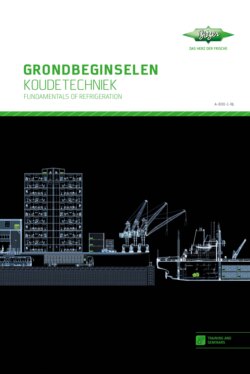Читать книгу GRONDBEGINSELEN KOUDETECHNIEK / In twee talen Nederlands/Engels - Volker Stamer - Страница 41
На сайте Литреса книга снята с продажи.
Оглавление43
Koeltechnische specificaties // Refrigeration parameters
f) Oververhitting = koudemiddeltemperatuur aan de
compressorintrede – verdampingstemperatuur
Δto2h = tV1h – to = 8°C – (–2°C) = 10 K
3.3
Vloeistofonderkoeling
3.3.1
Oorzaken van onderkoeling, definitie
Het expansieorgaan verlaagt het drukniveau van het
koudemiddel na het vloeibaar maken (verdampings-
druk). Voor een optimale werking moet bij de intrede
van het ventiel zuivere vloeistof aanwezig zijn. Figuurlijk
gesproken moet het koudemiddel zich door een vernau-
wing (duse) ‚persen‘. Gasvormig koudemiddel neemt in
vergelijking met een vloeibaar koudemiddel aanzienlijk
meer volume in. Dientengevolge heeft het gasvormige
koudemiddel meer tijd nodig om zich door deze ‚duse‘ te
‚persen‘. Het gasvormige koudemiddel vóór het expan-
sieventiel vermindert de doorstroomsneleid, wat resul-
teert in een te lage toevoer van koudemiddel naar de
verdamper (verhoogde oververhitting). Dit kan gepaard
gaan met sissende geluiden.
Fig. 7 Gasbellen vóór de duse
Bubbles upstream of the throttle gap (orifice) [BITZER]
Wanneer het koelsysteem nu zo is ontworpen, dat
de "inlaat van het expansieorgaan" zich direct aan
het einde van het condensatieproces bevindt, dan
kunnen er bij de geringste fluctuaties in de bedrijfsom-
standigheden, of bij een drukval in de leiding, vóór het
expansieorgaan bellen ontstaan.
Maatregelen voor een gegarandeerde vloeistof-
toevoer bij het expansieventiel:
Een mogelijkheid om gasbelvorming te voorkomen is
het installeren van een vloeistofvat (zie fig. 8). De
gasbellen worden hierin door de zwaartekracht van de
vloeistof gescheiden. In het hier getoonde reservoir
verlaat de vloeistof via de onderzijde het vloeistofvat en
wordt via de vloeistofleiding naar het expansieventiel
gevoerd. Het peil kan worden gecontroleerd met behulp
van kijkglazen.
f) Superheat = refrigerant temperature at compressor
inlet – evaporation temperature
Δto2h = tV1h – to = 8°C – (–2°C) = 10 K
3.3
Liquid subcooling
3.3.1
Reasons for subcooling, definition
The expansion device has the task of reducing the
refrigerant to a lower pressure level (evaporation
pressure) following the condensation process. For
optimum function, pure liquid must be present at the
valve inlet. Figuratively speaking, the refrigerant must
‘force’ itself through a constriction (throttle gap). Com-
pared to the liquid state, gaseous refrigerant occupies
a much greater volume. Consequently, the gaseous
refrigerant requires more time to ‘force’ itself through
the constriction. Gaseous refrigerant upstream of the
expansion valve reduces the flow rate and leads to
refrigerant undersupply in the evaporator (increased
superheat). This can also lead to hissing noises.
If the refrigeration system is now operated such that
the ‘expansion device inlet’ status lies directly at the
end of the condensing process, bubbles upstream of
the expansion device may occur given the slightest
fluctuation in the operating conditions or a pressure
drop in the pipe.
Measures to ensure liquid at the expansion valve:
One option for preventing bubble formation is to install
a high pressure receiver (see Fig. 8). Here, gas
bubbles are separated from the liquid using gravity. In
the receiver shown here, the liquid is removed at the
bottom and transferred through the liquid line to the
expansion valve. It is possible to check the level using
sight glasses.
